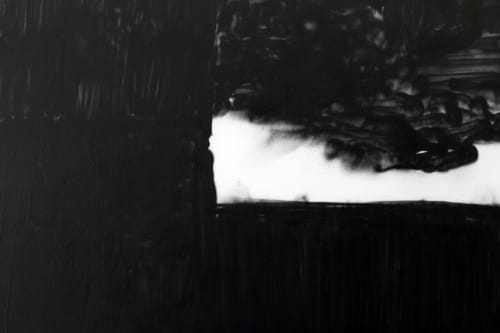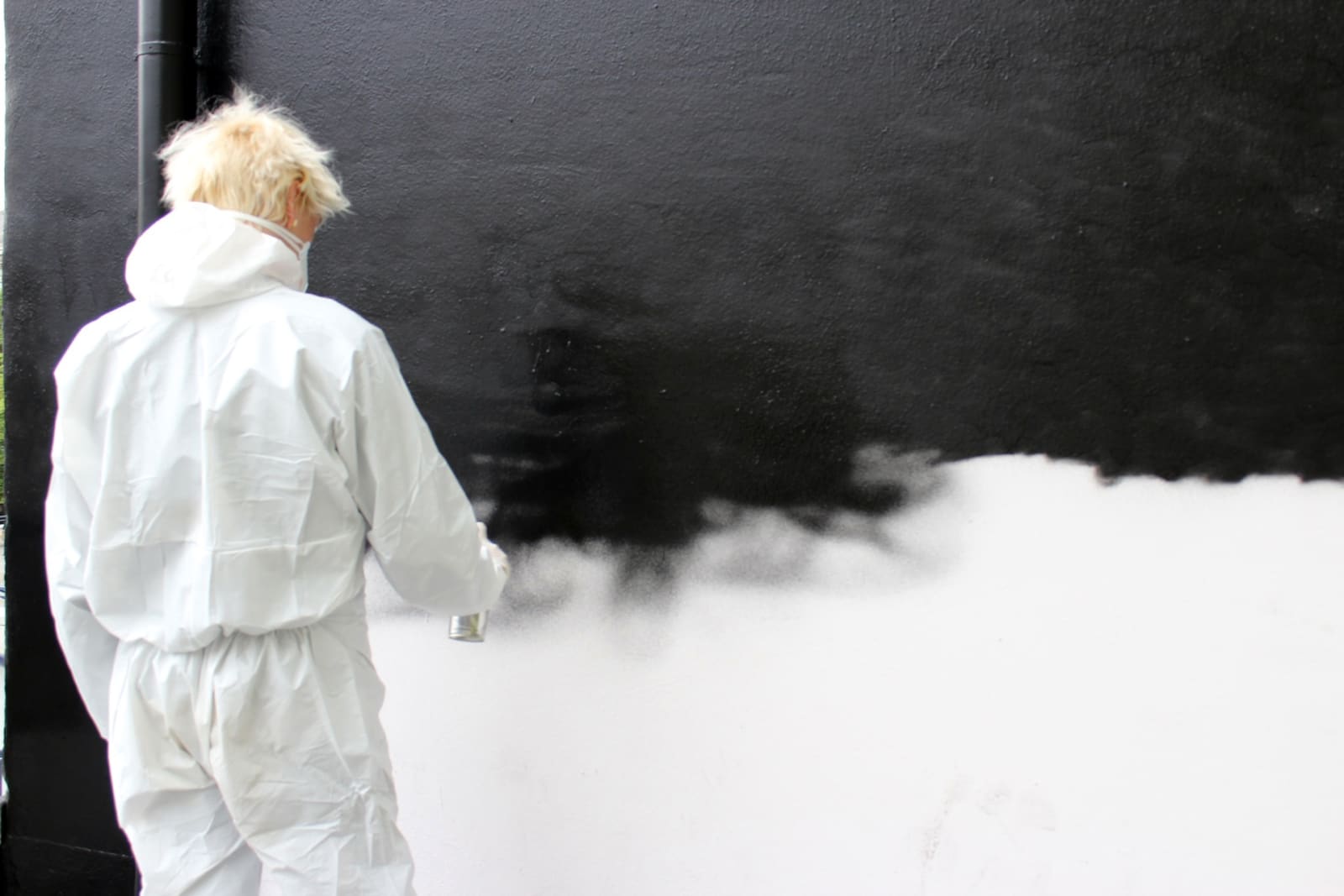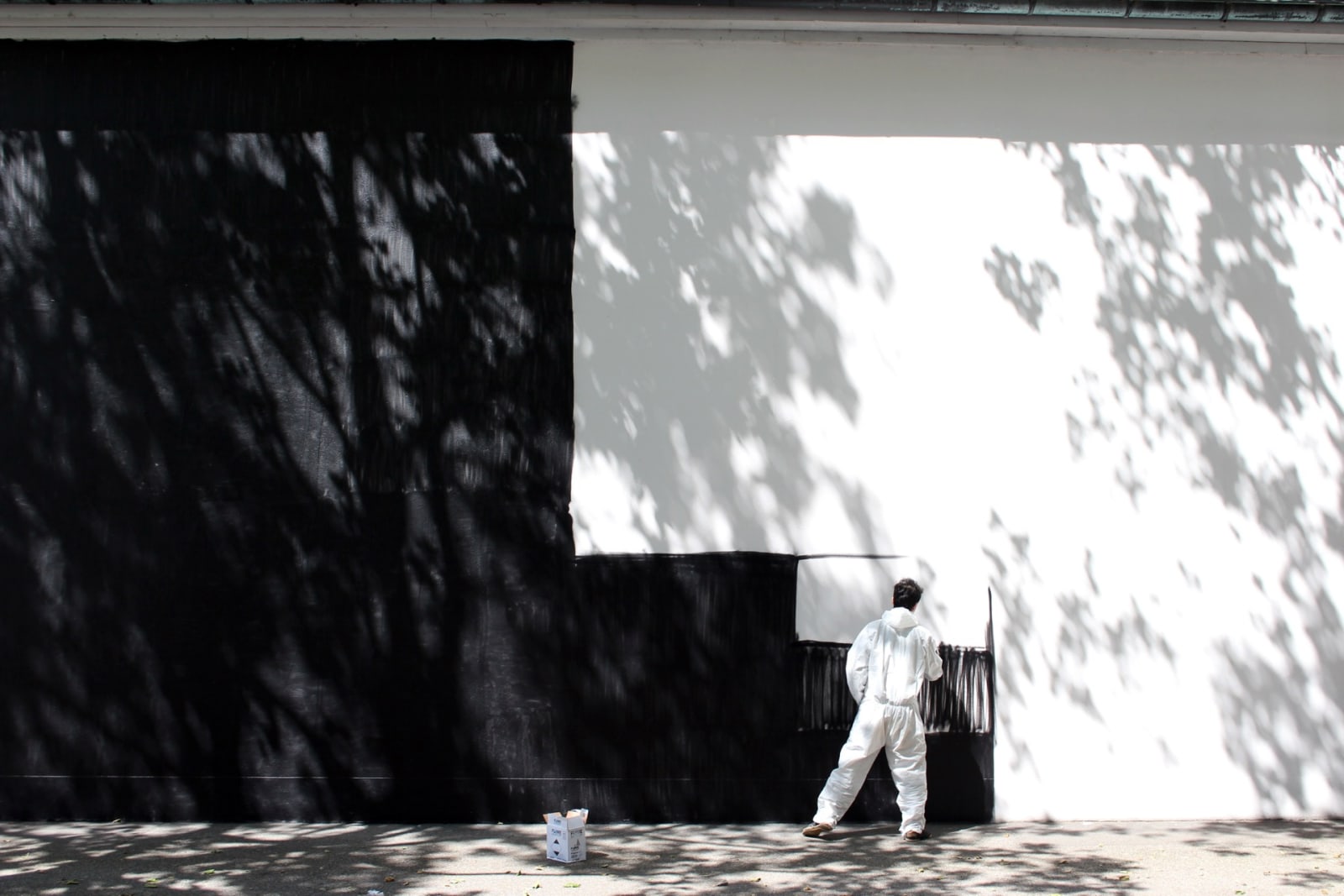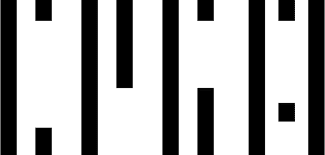Tercerunquinto invited young people with no experience of graffiti or artmaking to spray the wall, although not as part of a collaborative project but with the stipulation that each person worked on the wall alone, documented by the artists. Within the parameters set by Tercerunquinto, which included the colour (black) and the form (a blanket covering of the wall, with no signs or symbols), those taking part were free to decide how long they painted for and how much of the wall they covered. Their contributions gradually accumulated into an overall picture, in which individual gesture and authorship are neutralized in a monochrome plane. Tercerunquinto thus radicalizes a theme of art – monochrome painting – that has been a regular topic of the artistic discourse since Suprematism and Constructivism.
Founded as an artist collective in 1996 in Monterrey, Mexico, by Julio Castro Carreón (born 1976), Gabriel Cázares Salas (born 1978) and Rolando Flores Tovar (born 1975), Tercerunquinto pursues collaborative and context-based strategies that engage with specific architectural situations. Interventions in public spaces, and negotiations that investigate the terms and conditions of institutions, are core strands of their work. Not limited, by its very nature as a collective, to singular authorship, Tercerunquinto frequently involves outsiders, and in particular people unconnected with the world of the arts. It is their participation that rounds out and completes the collective’s works. Tercerunquinto lays bare what lies behind physical appearances, in works that depart from symptomatic points at which material and theoretical levels of meaning condense.
Since 1998 Tercerunquinto has treated the wall as motif and material in various contexts: as a sculptural element and in its architectural setting, with a focus on its institutional function, as a surface for signs, as a physical barrier and conceptual nexus. The artists are continually deconstructing and building walls, penetrating them, painting over them and uncovering them layer by layer.
Graffiti is one of the most commonly employed strategies of protest in public spaces. Anonymous, concise, confrontational, clandestine and fast, its slogans are indicators of an attitude hallmarked by dissatisfaction, unease and disillusionment. Tercerunquinto’s Graffiti addresses this same attitude, which seeks public expression in an act of rebellion and thereby challenges the ruling authorities. For young people in a state of latency typical of their age, still innocent in terms of active political participation and hence with no lasting public voice, spray-painting offers a first means of leaving marks on the ‘skin’ of the public space. The collectively produced image on the back wall of the Kunsthalle becomes an expression of the inhibited potential of youth.
The combination of text and image, so closely entwined in the elaborately stylized pieces of graffiti produced since the 1980s, aims at a symbolic occupation of the public space. These “empty signifiers”, as Baudrillard describes graffiti, insert themselves into the urban system of signs. These new signs remain disconcertingly illegible, since their referents are no longer accessible to outsiders. Tercerunquinto’s work combines the confrontational potential of written and pictorial statements in the public space – an illegal form of protest that has been practised since antiquity – with the persuasive power of art that, from its position in similarly public locations, communicates ideological programs in purely visual terms: from Romanesque church portals to the politically ideologically connoted wall paintings of the 20th century, such as Mexican muralismo.
For Tercerunquinto, the black surface, the black ‘picture’, finds its rationale in the understanding of public space as filled with signs. Graffiti is a picture that no longer shows anything. It is what it is, and is at the same time a projection screen full of references within its fundamental painterly parameters of plane and colour. The permeable surface simultaneously conceals and reveals the wall of the Kunsthalle that terminates the building at the back, and which thus marks the outer shell of the institution and the boundary between inside and outside. The picture makes this boundary both visible and porous: it links the wall as an architectural element with the interior that lies behind it and at the same time extends the exhibition space into the public space.
The black surface prompts a close reading of the wall within the surrounding architecture, insofar as it serves not only as a vehicle of information, but also as an element that defines public space. Created with the voluntary participation of young people within the parameters laid down by Tercerunquinto, the mural demonstrates, in exemplary fashion, the theory that public space is only produced and legitimized by the intentions and activities of the people associated with it.
Before spraying the wall, each participant was invited to answer a few questions on the subject of graffiti and protest. These interviews are documented in a video which is on show in the Kunsthalle’s lobby, and which complements the making of the mural. It gives moments of reflection a framework and at the same time shows the young people with a directness that conveys an impression of their latent potential.
Tercerunquinto’s works involve institution, participants and viewers in an open-ended process that pursues the question of how ideas can be brought to fruition in others.
Graffiti takes up from earlier works and continues Tercerunquinto’s exploration of the relationship between architecture and public space, individual and society, institution and artistic practice on the back wall of the Kunsthalle.
Curator: Ruth Kissling









